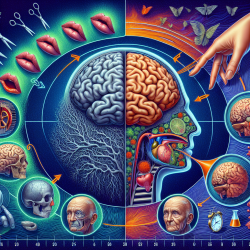Introduction
As speech-language pathologists, we continuously seek to improve our diagnostic and therapeutic approaches to ensure the best outcomes for our patients. Recent advancements in machine learning offer promising tools for enhancing our clinical practice, particularly in the diagnosis of complex conditions like frontotemporal dementia (FTD) and Alzheimer's disease (AD). A recent study titled "Machine learning based hierarchical classification of frontotemporal dementia and Alzheimer's disease" provides valuable insights that can be leveraged to refine our diagnostic processes and encourage further research in this area.
Understanding the Study
The study aimed to develop a machine learning-based hierarchical classification model to differentiate between various forms of dementia, including FTD subtypes and AD, using cortical thickness data obtained from MRI scans. The researchers recruited 143 patients with FTD, 50 patients with AD, and 146 cognitively normal subjects. They employed a hierarchical classification approach, training four classifiers to distinguish between different diagnostic categories in a stepwise manner:
- Step 1: Cognitively Normal (CN) vs. Dementia (FTD + AD)
- Step 2: FTD vs. AD
- Step 3: Behavioral variant FTD (bvFTD) vs. Primary Progressive Aphasia (PPA)
- Step 4: Semantic variant PPA (svPPA) vs. Non-fluent/agrammatic variant PPA (nfvPPA)
The hierarchical classification model achieved an overall accuracy of 75.8%, with individual step accuracies ranging from 86.1% to 92.1%. These results highlight the potential of machine learning to enhance diagnostic accuracy in clinical settings.
Implications for Clinical Practice
Implementing the findings from this study can significantly improve our diagnostic capabilities and patient outcomes. Here are some key takeaways:
1. Improved Diagnostic Accuracy
The hierarchical classification model demonstrated high accuracy in distinguishing between different forms of dementia. By integrating such machine learning tools into our diagnostic processes, we can reduce misdiagnosis and ensure that patients receive appropriate interventions tailored to their specific condition.
2. Enhanced Understanding of Cortical Atrophy Patterns
The study identified specific brain regions critical for differentiating between FTD subtypes and AD. For instance, changes in the right frontotemporal area were crucial for distinguishing bvFTD from PPA, while the left frontal lobe was significant for differentiating nfvPPA from svPPA. Understanding these patterns can help clinicians make more informed decisions when interpreting MRI scans.
3. Personalized Interventions
Accurate diagnosis at the individual level allows for more personalized interventions. For example, knowing whether a patient has bvFTD or svPPA can guide the selection of targeted therapies and support services, ultimately improving patient outcomes.
4. Encouragement for Further Research
The study's success in using machine learning for dementia classification underscores the importance of continued research in this field. Practitioners are encouraged to stay abreast of emerging technologies and consider participating in or conducting research to further refine these tools and expand their applications.
Conclusion
Integrating machine learning-based classification models into clinical practice holds great promise for enhancing the diagnosis and treatment of dementia. By leveraging data-driven insights and continuing to explore innovative approaches, we can improve outcomes for our patients and advance the field of speech-language pathology.
To read the original research paper, please follow this Machine learning based hierarchical classification of frontotemporal dementia and Alzheimer's disease.










